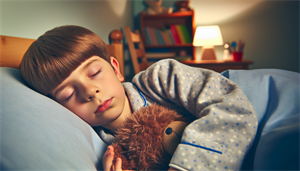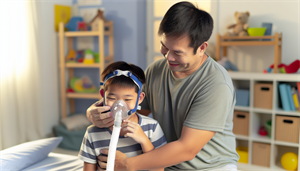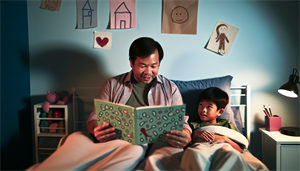Sleep apnea affects many children with autism, impacting their behavior and development. This concise guide illuminates the crucial links between autism and sleep apnea, offering clear explanations on symptom recognition, the intricacies of diagnosis, and effective therapies to enhance these children’s lives.
Key Takeaways
-
Children with Autism Spectrum Disorder (ASD) have a higher prevalence of Obstructive Sleep Apnea (OSA) symptoms compared to children without ASD, indicating a need for better screening and diagnostic processes for sleep disorders in the ASD population.
-
Symptoms of OSA in children with ASD, such as snoring, sleep disturbances, and cognitive challenges, can overlap with and be mistaken for ASD-related behaviors, leading to delayed OSA diagnosis and treatment.
-
Effective management of OSA in children with ASD involves a combination of interventions, including non-invasive therapies like CPAP, potential surgical procedures, lifestyle modifications, and establishing healthy sleep patterns and routines.
Unraveling the Connection: Autism Spectrum Disorder and Obstructive Sleep Apnea

The prevalence of OSA in children diagnosed with ASD has been a subject of escalating interest in recent years. Studies suggest a notable correlation between the two conditions, with children diagnosed with autism exhibiting more pronounced symptoms of sleep apnea. The disparity in reported OSA symptoms between children with and without ASD is also quite notable. Children with ASD have a higher prevalence of symptoms reported, indicating a significant between-group difference in OSA symptoms.
However, this disparity can lead to complexities in the diagnosis process. Certain symptoms of OSA might coincide with and manifest as symptoms linked to ASD during childhood, potentially causing the symptoms of OSA to be overlooked. This overlap can result in delays in OSA diagnosis, thereby underscoring the importance of considering sleep disorders when evaluating children with ASD.
Defining OSA in the Context of ASD
Grasping the relationship between asd obstructive sleep apnea and ASD is key to understanding their interconnectedness. Obstructive Sleep Apnea (OSA) is a medical condition characterized by the relaxation of throat muscles, leading to the obstruction of the airway and resulting in intermittent breathing pauses during sleep. The manifestation of OSA symptoms in children with ASD can vary, with a higher prevalence of symptoms reported in this group compared to children without ASD.
This higher prevalence of OSA symptoms in children with ASD does not correlate with ASD-specific comorbidities, indicating that symptoms such as loud snoring and changes in cognitive function may occur independently of other ASD-specific issues.
The Impact of OSA on Children with ASD
OSA in children with ASD can notably affect their behavior, cognitive ability, and overall quality of life. OSA can result in:
-
Daytime behavioral issues
-
Worsened pain-related symptoms
-
Increased anxiety levels
-
Contributed to depressive symptoms
-
Increased rates of obesity and hypotonia associated with OSA can subsequently impact cognitive functions such as attention and alertness
-
Louder snoring
-
Increased daytime sleepiness
The physical health of children with ASD can also be negatively impacted, with OSA contributing to increased rates of obesity and hypotonia. Furthermore, OSA can exacerbate difficulties in attention and hyperactivity, oppositional behaviors, heightened aggression, decreased social skills, less effective communication, and reduced cognitive abilities, significantly impacting the emotional and social well-being of children with ASD.
Diagnosing Challenges: OSA in the ASD Population
Identifying OSA in children with ASD poses distinct difficulties. As previously mentioned, the symptoms of OSA might coincide with those linked to ASD, potentially causing an oversight of an OSA diagnosis. The primary means for diagnosing OSA is overnight polysomnography (PSG), but children with ASD may encounter difficulties in completing a PSG due to:
-
the necessity for multiple attempts
-
discomfort with the unfamiliar environment
-
discomfort with unfamiliar people
-
discomfort with unfamiliar sounds
-
discomfort with unfamiliar stimulations
Moreover, diagnosing OSA in children with ASD differs due to reduced research emphasis on utilizing PSG. It is therefore advisable to assess children with milder autism for sleep apnea as they may exhibit a greater array of symptoms that could result in a potential delay in OSA diagnosis, especially if they also have an elevated body mass index.
The Symptom Spectrum: Identifying OSA in Children with Autism

The symptoms of OSA in children with ASD can range from the obvious to the subtle. The more conspicuous symptoms, such as loud snoring and excessive daytime sleepiness, are often the first indicators that a child may be suffering from OSA. However, there are less conspicuous symptoms that may go unnoticed or be disregarded. These may encompass issues with breathing, choking or coughing during sleep, mouth breathing, frequent illness, and restlessness.
Identifying the wide range of OSA symptoms in children with autism is key to ensuring precise diagnosis and treatment. The following sections delve deeper into:
-
The common and less obvious indicators of OSA
-
The influence of age and ASD severity on OSA diagnosis
-
The importance of early detection and intervention.
Loud Snoring and Other Tell-tale Signs
Loud snoring is a common symptom of OSA in children with ASD. However, it is not the only tell-tale sign of this condition. Other primary indicators of OSA in children include:
-
pauses in breathing
-
restless sleep
-
snorting, coughing or choking
-
mouth breathing
-
nighttime sweating
-
bed-wetting
Apart from snoring, children with ASD who have OSA may also exhibit symptoms such as excessive daytime sleepiness and alterations in cognitive function.
Beyond the Nighttime Disturbances
While loud snoring and other nighttime disturbances are common indicators of OSA in children with ASD, the symptoms of this condition extend beyond these nighttime disturbances. Daytime behavioral changes such as:
-
hypotonia
-
obesity
-
sleep disturbances
-
attention problems
-
aggression
-
decreased social competence
-
impaired communication
-
reduced overall well-being
can indicate the presence of OSA in children with ASD.
Cognitive manifestations of OSA can include increased daytime drowsiness and alterations in cognitive abilities, leading to potential issues with attention and communication. The effects of OSA on the physical health of children diagnosed with ASD, including increased rates of obesity and hypotonia, can further contribute to behavioral issues and affect their daytime well-being.
When Symptoms Overlap: Disentangling ASD and OSA Indicators
Differentiating between ASD and OSA symptoms to facilitate accurate diagnosis and treatment can pose a challenge. There are several prevalent symptoms shared between ASD and OSA, such as loud snoring, difficulty falling asleep, and frequent awakenings. These symptoms have the potential to intersect and intensify each other, leading to possible complexities in diagnosing OSA in children with ASD.
OSA symptoms can also resemble the communication and social interaction difficulties observed in ASD, further complicating the diagnostic process. To address these challenges, clinicians have at their disposal various assessment tools, including polysomnography (PSG), patient history, and physical examination.
Age and Severity: Factors Influencing OSA Diagnosis in Children with ASD

Several factors, including age and ASD severity, impact the diagnosis of OSA in children with ASD. Studies suggest that lower autism severity is linked to an increased number of reported OSA symptoms, indicating a higher symptom burden in individuals with less severe ASD. This relationship between lower ASD severity and the number of reported OSA symptoms suggests that children with milder autism may experience a higher burden of symptoms due to delayed diagnosis.
Furthermore, the influence of age on the diagnosis of OSA in children with ASD is not fully understood. However, it has been observed that children with milder autism may experience potentially delaying OSA diagnosis, possibly due to a greater manifestation of symptoms that may be incorrectly attributed to their developmental condition rather than a sleep disorder.
The Role of Age in OSA Symptom Presentation
The manifestation of OSA symptoms can vary with age in children with ASD. The typical age of onset for Obstructive Sleep Apnea (OSA) in children is between 2 and 6 years old, during which snoring is frequently observed among children younger than five years.
Age may also have an influence on the severity of OSA symptoms in children with ASD, with younger children exhibiting higher rates of hypotonia and older children experiencing a greater burden of symptoms due to delayed age at OSA diagnosis.
Correlation Between Lower ASD Severity and OSA Symptoms
There appears to be a direct correlation between the severity of autism and the manifestation of OSA symptoms. Children with milder autism are more prone to experiencing increased symptoms of Obstructive Sleep Apnea (OSA) and receiving a diagnosis. This greater prevalence of OSA symptoms in children with less severe autism may be due to a delay in diagnosis.
Research studies have indicated a higher prevalence of OSA symptoms in children with milder autism spectrum disorder (ASD) in comparison to the general pediatric population.
The Significance of Early Detection and Intervention
The significance of prompt identification and intervention in handling OSA in children with ASD is paramount. Early diagnosis serves as the initial phase of intervention that can significantly enhance outcomes for these children. Timely intervention for OSA can result in enhancements in behaviors and the general well-being of children with ASD.
In addition, early treatment of OSA can help prevent severe consequences and enhance autism symptoms, such as:
-
decreasing anxiety levels
-
reducing depressive symptoms
-
improving sleep-related issues
-
enhancing behavioral outcomes By addressing these issues, it may also help to avoid actions that could exacerbate symptoms.
Early intervention offers access to comprehensive support, personalized treatment plans, and improvement in overall outcomes.
Treatment Approaches: Managing OSA in Children with Autism Spectrum Disorder

Handling OSA in children with ASD requires a comprehensive approach, encompassing:
-
Non-invasive therapies, such as Continuous Positive Airway Pressure (CPAP) therapy, which is often the first line of defense against OSA
-
Surgical procedures, including adenotonsillectomy, which may be considered when non-invasive therapies are unable to effectively manage OSA
-
Lifestyle changes
Lifestyle modifications, such as regular physical activity, a balanced diet, and abstaining from alcohol and tobacco, can also contribute significantly to the management of OSA in children with ASD.
Non-Invasive Therapies: CPAP and Beyond
Continuous Positive Airway Pressure (CPAP) therapy is a widely used non-invasive treatment for OSA. It involves the use of a mask over the nose or mouth during sleep to deliver a continuous flow of air, thereby preventing airway collapse and ensuring normal breathing throughout the night. CPAP therapy has demonstrated effectiveness in alleviating symptoms associated with sleep apnea, such as snoring and daytime drowsiness, and enhancing the overall quality of sleep.
However, the effectiveness of CPAP therapy in improving sleep efficiency or REM sleep in children with Autism Spectrum Disorder (ASD) who have obstructive sleep apnea (OSA) may be limited.
Surgical Considerations and Interventions
When non-invasive therapies fail to manage OSA effectively, surgical interventions may be considered. These primarily include uvulopalatopharyngoplasty (UPPP) and procedures aimed at enhancing or eliminating airway collapse during sleep. Adenotonsillectomy has demonstrated effectiveness as a treatment for OSA in children, including those diagnosed with autism. It is worth noting that surgical interventions carry potential risks, such as tracheoesophageal fistula, decannulation, and tracheostomy tube obstruction. Therefore, the recommendation for surgical intervention, specifically tonsillectomy with or without adenoidectomy (T&A), should be carefully considered.
Lifestyle Adjustments and Support Strategies
Lifestyle adjustments and support strategies can play a crucial role in managing OSA in children with ASD. Effective lifestyle modifications include:
-
Weight reduction
-
Avoidance of alcohol and smoke exposure
-
Adherence to a healthy diet
-
Regular exercise
-
Implementation of behavioral strategies following adenotonsillectomy.
Dietary adjustments and consistent sleep hygiene can significantly contribute to the management of OSA in children with ASD. Some strategies to consider include:
-
Maintaining consistent sleep hygiene to improve sleep quality, reduce anxiety levels, and fortify cognitive and behavioral functioning.
-
Implementing standard protocols for conducting polysomnography to accurately diagnose OSA.
-
Employing interventions to encourage sleep engagement and address any sleep disturbances.
Parents and caregivers can utilize these support systems to help manage OSA in children with ASD.
Research Insights: Understanding the ASD-OSA Relationship
The link between ASD and OSA in children remains an active area of research, continually advancing. While there have been limited studies examining the disparities in OSA diagnosis between children with and without ASD, research over the years has consistently demonstrated a significant correlation between the two conditions, with a higher occurrence of OSA in children with ASD as opposed to the overall population.
Studies have also indicated that specific genetic conditions, such as Fragile X syndrome, Down syndrome, and Duchenne muscular dystrophy, are prevalent in children with ASD and there is a significant association between these children and the presence of OSA. This highlights the importance of further research and understanding of the asd group.
Key Studies and Their Conclusions
The understanding of the ASD-OSA relationship has been significantly enhanced by numerous primary research studies, including a literature review that analyzed the relationship between sleep-disordered breathing and children with autism spectrum disorder. These studies have established a correlation between ASD and the occurrence of OSA in children, indicating that children with less severe autism may experience a higher burden of symptoms due to delayed diagnosis.
These findings have enriched our comprehension of the ASD-OSA relationship by:
-
Emphasizing the frequency of sleep issues in children with ASD
-
Evaluating the impact of ASD severity on OSA symptoms and age at diagnosis
-
Illustrating that children with milder autism may endure a greater load of symptoms due to delayed OSA diagnosis.
Implications for Future Research and Practice
While significant progress has been made in understanding the ASD-OSA relationship, there are still several areas that require further investigation. The existing research suggests a greater prevalence of OSA symptoms in children with milder forms of ASD, mainly attributed to delays in diagnosis. Therefore, subsequent research should focus on understanding the influence of sleep-disordered breathing in children with ASD and exploring the correlation between ASD symptom severity and OSA diagnosis.
In addition, research can play a pivotal role in improving the identification and management of OSA in children with ASD by:
-
Comparing symptoms and diagnosis timing in children with and without ASD
-
Utilizing polysomnography
-
Identifying at-risk children
-
Evaluating home sleep studies and behavioral sleep training
-
Improving early detection and treatment to mitigate negative outcomes.
Navigating Daily Life: Practical Tips for Parents and Caregivers

ASD and OSA can profoundly affect a child’s life, but with appropriate strategies and resources, parents and caregivers can assist these children in leading a balanced and healthy life. Creating regular sleep patterns is vital in handling OSA symptoms. This involves implementing bedtime routines, regular bedtimes, healthy sleep associations, and creating a comfortable sleep environment.
Furthermore, caregivers can manage behavioral challenges exhibited by children with ASD and OSA by:
-
Employing clear communication
-
Utilizing visual supports
-
Maintaining consistent routines
-
Keeping a behavior diary
-
Ruling out medical causes
-
Implementing positive reinforcement
-
Redirecting to alternative activities
These strategies can help caregivers better understand and manage behavior.
Establishing Healthy Sleep Patterns
Establishing healthy sleep patterns for children with ASD and OSA involves implementing bedtime routines that include relaxing activities, such as reading or listening to calming music. Also, creating a sleep environment that is dark, quiet, comfortable, and cool can contribute to better sleep quality.
It is also recommended to:
-
Keep a sleep diary
-
Practice good sleep hygiene
-
Limit screen time
-
Maintain a consistent sleep routine and schedule
These practices can help foster healthy sleep patterns and assist in managing sleep.
Coping with Behavioral Challenges
Children with ASD and OSA may exhibit a range of behavioral challenges, including attention deficits, aggressive tendencies, decreased social skills, communication obstacles, inattentiveness, hyperactivity, and externalizing issues. Effective coping strategies for managing these behavioral issues include establishing bedtime routines, practicing systematic ignoring, bedtime fading, strategic napping, and using positive reinforcement.
Furthermore, responsive interaction with the child and applying calming strategies such as mindfulness exercises and deep breathing are crucial in addressing these issues. Behavioral interventions, such as individualized sleep interventions and potentially surgical treatments like adenotonsillectomy, have proven successful in not only alleviating sleep disturbances but also addressing the consequential behavioral problems.
Seeking Professional Help: When to Consult Experts
Identifying the right time to seek expert assistance for a child with ASD and OSA is paramount. Professional intervention should be considered when a child shows milder autism symptoms but displays evident indications of sleep apnea, such as tiredness, grogginess upon waking, bedwetting, teeth grinding, and substantial daytime drowsiness. Caregivers are advised to seek consultation from pediatric sleep specialists, pediatric ear, nose, and throat specialists, and healthcare professionals experienced in treating sleep issues in children with autism for managing OSA.
Dentists and otolaryngologists also play a critical role in the early detection and management of OSA. The frequency of consultations with healthcare professionals for a child with autism’s obstructive sleep apnea should adhere to the recommendations provided by medical and dental experts.
Summary
The intersection of ASD and OSA in children presents a complex challenge that necessitates a comprehensive understanding and an integrated approach to diagnosis and treatment. This blog post has explored the intricate relationship between ASD and OSA in children, highlighting the unique challenges posed by this association and the various strategies for managing it.
In conclusion, understanding the relationship between ASD and OSA is not just a matter of academic interest but a crucial aspect of improving the quality of life for children with ASD. Armed with this knowledge, parents, caregivers, and healthcare professionals can work together to ensure that these children receive the care and support they deserve.
Frequently Asked Questions
Is sleep apnea common in autism?
Yes, obstructive sleep apnea is common in autism spectrum disorder, with children displaying symptoms such as loud snoring, excessive daytime sleepiness, and changes in cognitive function.
Does autism cause sleep problems?
Yes, autism can cause sleep problems in both children and adults, affecting over half of children with autism and many adults on the spectrum as well. These sleep problems may include difficulty falling asleep and staying asleep through the night.
What sleep disorders do people with high functioning autism have?
People with high functioning autism often experience various sleep disorders, such as difficulty falling and staying asleep, insomnia, and restless legs syndrome. These issues can affect between 50% and 80% of individuals with autism.
Symptoms of sleep apnea?
If you experience symptoms such as loud snoring, gasping for air during sleep, or excessive daytime sleepiness, it could be a sign of sleep apnea. Seek medical advice to get diagnosed and treated.
What challenges exist in the identification of OSA in children with ASD?
Identifying obstructive sleep apnea in children with autism spectrum disorder can be challenging due to overlapping symptoms, leading to potential misdiagnosis or oversight. Careful assessment and consideration of both conditions are necessary for accurate diagnosis and appropriate treatment.


